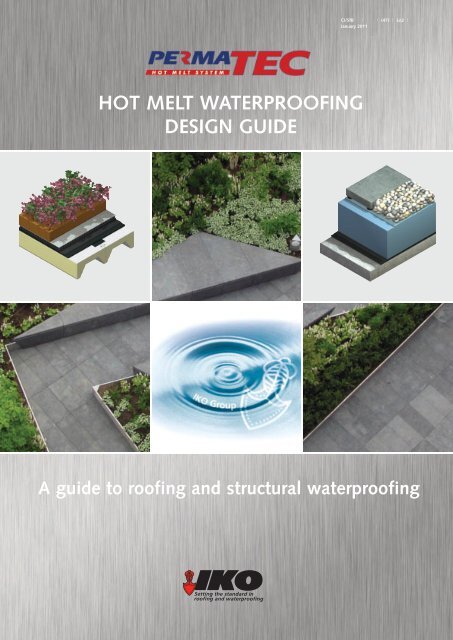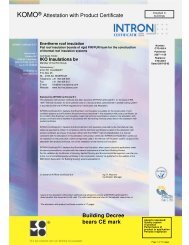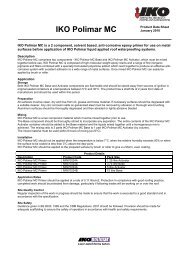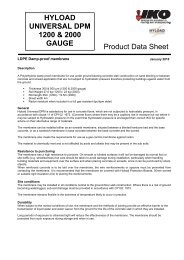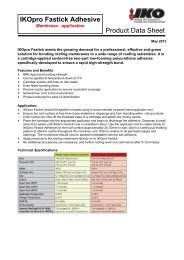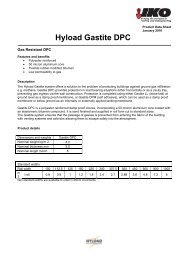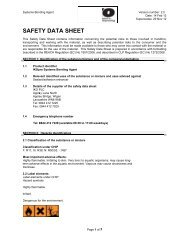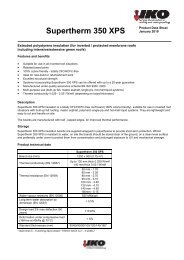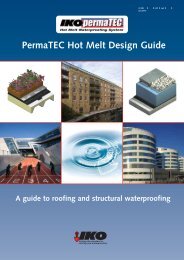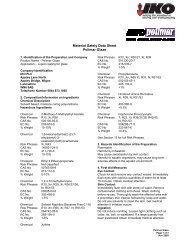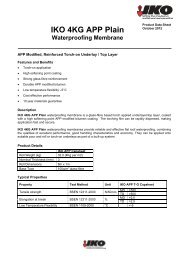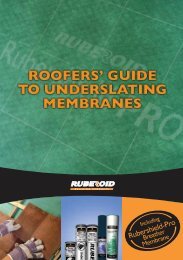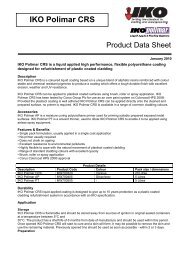Download the PermaTEC Design Guide - IKO
Download the PermaTEC Design Guide - IKO
Download the PermaTEC Design Guide - IKO
- No tags were found...
Create successful ePaper yourself
Turn your PDF publications into a flip-book with our unique Google optimized e-Paper software.
CI/SfB (47) Ln2January 2011HOT MELT WATERPROOFINGDESIGN GUIDEA guide to roofing and structural waterproofing
2 PERMATEC DESIGN GUIDEThis page and opposite:Ropemaker Place, LondonMACE, 2010“I first worked with hot melt waterproofing on <strong>the</strong>Broadgate Development in 1988, and I’ve been usingit successfully ever since.”Bob Gordon, Chief Engineer, MACE
PERMATEC DESIGN GUIDE 3ContentsComplete structural waterproofing 4-5The versatile roofing solution 6Environmental benefits 7Why specify an inverted roof? 8-9<strong>Design</strong> considerations 10-13Simple solutions for difficult problem areas 14-15Inverted ballasted roof specification 16Podium deck specification 17Intensive green roof specification 18Extensive green roof specification 19Biodiverse green roof specification 20Structural waterproofing specification 21Typical details 22-27System components 28-29Setting <strong>the</strong> Standard in Innovation,Quality and Service30-31Images courtesy of Frosts Landscape Constructionwwww.ikoroofing.co.uk
4 PERMATEC DESIGN GUIDEComplete structural waterwww.ikoroofing.co.uk
PERMATEC DESIGN GUIDE 5proofing with <strong>PermaTEC</strong>Extensive green roofLightweight green roof system, usuallyincorporating sedum mats or sedum plug plantsand minimal growing medium (concrete, metal orcomposite decks). See page 19.Inverted ballasted roofMost popular hot melt system build up, usuallyinstalled onto a concrete deck (alternative deckscan be used). See page 16.Inverted roof on metal deckwith cement boardRecent addition to <strong>the</strong> list of acceptable structural decks.Intensive green roofHeavyweight green roof system, usually incorporatingbushes, trees, grass etc, and an appropriate depth ofgrowing medium to support <strong>the</strong>m. See page 18.Podium deckOften used over undercroft car parks to retail andresidential buildings, usually uninsulated. See page 17.Substructure waterproofingVertical surface waterproofing to car parks etc. Also usedunderneath floor slabs. See page 21.wwww.ikoroofing.co.uk
6 PERMATEC DESIGN GUIDE<strong>PermaTEC</strong> hot melt waterproofing -<strong>the</strong> versatile roofing solutionHot melt waterproofing has asuccessful track recordstretching back over 40 years.Today, many prestigiousbuildings in <strong>the</strong> UK haveincorporated a hot meltsystem, thanks to itsoutstanding waterproofingperformance and unrivalleddesign flexibility.<strong>PermaTEC</strong> is a hot applied membrane whichis manufactured from a specially formulatedcombination of refined bitumen, syn<strong>the</strong>ticrubbers, fillers and o<strong>the</strong>r additives. It ismelted in a purpose built machine and isapplied to a prepared structural deck in twonominal 3mm coats, providing a monolithicwaterproofing system. It is suitable for use as<strong>the</strong> waterproofing layer in most new build flatroofing applications, when covered bysuitable protection or when used in aninverted roof or green roof specification.Key benefitsLifetime performance• Formulated to last for <strong>the</strong> lifetime of <strong>the</strong>building or structure on which it is installed• Long-term waterproofing integrity• No future replacement costsFully bonded and monolithic• Applied as a liquid directly to <strong>the</strong> deck• No risk of water tracking below <strong>the</strong>membrane• Completely seamless so no possibility of lapfailureFlexibility of design• No screeds to falls required meaning lesscost, weight and time• Unaffected by standing water, dilute acidsand fertilisers• Effective detailing to difficult penetrationslike ‘I’ beams, posts etc.Safe, speedy installation• No two part system to mix• No on-site curing requirements• Solvent-free formulationIdeal for demanding site conditions• Excellent low temperature flexibility andadhesion• Can be readily applied in temperaturesdown to -18ºC on a clean, dry, frost-freesurface• Work can proceed during winter months,minimising lost construction time• <strong>PermaTEC</strong> is not affected by rain, snow orfrost immediately after its application• Can be walked on immediately afterinstallation of <strong>the</strong> systemQuality workmanship on every project• <strong>PermaTEC</strong> is only installed by trained andbadged operatives• Dedicated <strong>IKO</strong> engineers monitoring all siteinstallations• Long-term, meaningful guarantees forultimate peace of mind“Hot melt has risen to become <strong>the</strong>first choice for many specifiersseeking a reliable, long-termwaterproofing solution.”www.ikoroofing.co.uk
PERMATEC DESIGN GUIDE 7Environmental benefits of <strong>PermaTEC</strong>We all have a fundamentalresponsibility to reduce to anabsolute minimum <strong>the</strong> carbonfootprint of any product andsystem that we use. Everyonein <strong>the</strong> construction industryshould seek to sourceproducts and systems ‘locally’on a best value basis.<strong>IKO</strong> is determined to set new standards ofexcellence in <strong>the</strong> efficiency and performanceof hot melt systems in <strong>the</strong> UK – coveringboth manufacture and installation.In 2002, <strong>IKO</strong> was <strong>the</strong> first to offer safer,more convenient product packaging to <strong>the</strong>roofing contractors. This resulted in <strong>the</strong> NorthAmerican manufacturers changing from 45gallon steel oil drums to thick cardboardboxes and plastic wrappers.In 2008, <strong>IKO</strong> was <strong>the</strong> first to offer zerowrapper waste and <strong>the</strong> first to develop lowerapplication temperatures. In 2010, itcontinued to innovate <strong>the</strong> market bydeveloping a hot melt compound with builtinanti-root protection.<strong>IKO</strong> has also lobbied <strong>the</strong> UK manufacturers ofhot melt machines to develop more effectiveequipment, to enable <strong>the</strong> material to bemelted faster and at lower temperatures, thusreducing energy consumption on site. <strong>IKO</strong>understands that it has a responsibility tocontinually develop its products and systemsto minimise <strong>the</strong>ir impact on <strong>the</strong> environment.First to manufacture in <strong>the</strong> UK• Provides <strong>the</strong> most efficient carbonfootprint delivery miles• <strong>IKO</strong> manufactures all systemcomponents• Less logistics worries - <strong>IKO</strong> delivers fromfactory to site in one operation• Delivery miles kept to minimum• No need to buy full containers• No need for expensive storage andreloading• No lengthy lead timesZero wrapper waste• Significantly less on-site waste anddisposal costs, 98.5% less <strong>the</strong>ncardboard boxes• Increased site efficiency - no openingand disposing of cardboard boxes• Environmental status improved for clientsand specifiers• Helps contractors to achieve Site WasteManagement PlansLow melt technology• Application temperature reduced by 20%• Saves preparation time: material can beready sooner• Reduces energy consumption• Melter machines can be more productive• Material remains ‘workable’ longer• Fully compliant with REACH regulations“<strong>PermaTEC</strong> was <strong>the</strong> first hot meltsystem manufactured in <strong>the</strong> UK.”<strong>PermaTEC</strong> Anti-Root<strong>PermaTEC</strong> Anti-Root is <strong>the</strong> world's firstmonolithic 'anti-root' hot melt structuralwaterproofing system. The latest innovationfrom <strong>IKO</strong>, eliminating <strong>the</strong> need for a separateanti-root membrane, <strong>the</strong>reby making <strong>the</strong>specification and installation process bothsimpler and more cost-effective. For addedreliability and peace of mind <strong>the</strong> <strong>PermaTEC</strong>Anti-Root compound provides a nominal6mm thick monolithic barrier system withoutside or end laps.Less rolls, fewer pallets, less transport,less hoisting, more savings.wwww.ikoroofing.co.uk
8 PERMATEC DESIGN GUIDEWhy specify an inverted roof?Cold roofsTypical specificationTimber joists supporting plywood panels. In <strong>the</strong> past tongued andgrooved timber boarding or chipboard were used. Waterproofingsystems (built up bitumen felt, mastic asphalt, single ply membranes)are installed (using various means of attachment) to <strong>the</strong> top of <strong>the</strong>timber deck. Foil backed plasterboard to <strong>the</strong> soffit, with fibreglassinsulation above and an air space above <strong>the</strong> insulation.Key considerationsExternal problems for cold roofs include extremes of temperatures,ultra violet, wea<strong>the</strong>r (rain, wind, snow etc), fire and physical damage!Internal problems for cold roofs include vapour driving through <strong>the</strong>plasterboard, through <strong>the</strong> insulation into <strong>the</strong> air space under <strong>the</strong> timberdeck. In winter, warm moist air vapour comes into contact with <strong>the</strong>underside of <strong>the</strong> cold deck and, if not adequately ventilated,condensation forms and drops back onto <strong>the</strong> top of <strong>the</strong> insulation, andeventually onto <strong>the</strong> top of <strong>the</strong> plasterboard causing damp stains to <strong>the</strong>underside.Warm roofsTypical specificationThere are three preferred structural decks, concrete, timber (plywood)and <strong>the</strong> most popular being profiled galvanised metal deck on steelpurlins. These deck systems are usually installed flat. Metal deckingand plywood could be installed to falls at extra cost.Warm roofs normally require a vapour control membrane (varioustypes available) to be installed (by various means of attachment) to <strong>the</strong>top of <strong>the</strong> decking system.Insulation material (e.g. rigid polyurethane, mineral wool etc.) isinstalled using various means of attachment to <strong>the</strong> top of <strong>the</strong> vapourcontrol membrane.Waterproofing systems (built up bitumen felt, mastic asphalt, single plyand cold applied liquids) are installed over <strong>the</strong> insulation layer.Key considerationsExternal considerations for warm roofs are <strong>the</strong> same as those for coldroofs, due to <strong>the</strong> waterproofing system being totally exposed.Fur<strong>the</strong>rmore <strong>the</strong> compressive strength of most of <strong>the</strong>se types ofinsulations is unsuitable for use where installations involve heavy loadsand impact damage.There are less internal concerns for warm roofs than cold roofs, butextra care must be taken to ensure that <strong>the</strong> vapour control membraneis sealed at all laps and abutments/penetrations, so that vapour cannotpass through any gaps into <strong>the</strong> insulation zone, <strong>the</strong>rby increasing <strong>the</strong>risk of condensation.www.ikoroofing.co.uk
PERMATEC DESIGN GUIDE 9Inverted roofsTypical specificationMost inverted roofs are installed on concrete decks with zero falls(completely flat), alternative systems like plywood or calcium silicateboards can be installed onto timber joists or metal deck substrates, ormetal/insulation composite panels can be used. Waterproofing systems(built up bitumen felt, mastic asphalt, single ply, cold applied and hotmelt) are installed (using various methods) to <strong>the</strong> deck. Hot melt is fullybonded to <strong>the</strong> deck.To comply with relevant codes of practice and BBA certification most of<strong>the</strong> waterproofing systems require falls to be introduced ei<strong>the</strong>r within <strong>the</strong>structure or using a screed. An inverted roof using hot melt waterproofingdoes not require falls. The only insulation material suitable for an invertedroof system is extruded polystyrene (XPS), which is loose laid onto <strong>the</strong> topof <strong>the</strong> waterproofing system (some waterproofing membranes need to beisolated from <strong>the</strong> XPS). This type of insulation is extremely strong with acompressive strength which can support at least 130 kN/m 2 (13 tonnesper m 2 ).A proprietary separation membrane is installed loose laid on top of <strong>the</strong>insulation to improve <strong>the</strong> overall U-value of <strong>the</strong> insulation system. Theloose laid insulation and separation layer needs to be weighed down toprevent it being blown off <strong>the</strong> roof. Ballasting materials are used such asround washed stones or concrete pavers on supports, <strong>the</strong> minimum ballastweight required is 80kg/m 2 .Key considerationsAlthough one of <strong>the</strong> main benefits of inverted roof design is that <strong>the</strong>waterproofing membrane is totally protected, <strong>the</strong>re are two importantdesign factors to be considered.Firstly, <strong>the</strong> structural deck should be capable of supporting <strong>the</strong> weightloading of an inverted roof system, which would usually be between95kg/m 2 and 140kg/m 2 .Secondly, it is essential to ensure that <strong>the</strong> waterproofing system is fullytested (usually electronically or flood test) for damage prior to <strong>the</strong>installation of <strong>the</strong> insulation and loading coat (ballast/pavers/green roof).Failure to discover and repair any damage could lead to <strong>the</strong> timeconsuming and costly removal of <strong>the</strong> loading coat and insulation to access<strong>the</strong> waterproofing system.“One of <strong>the</strong> main advantages of this form of construction is its simplicity. With <strong>the</strong>wea<strong>the</strong>rproofing acting also as a vapour barrier, <strong>the</strong> need for complicatedcalculation can often be avoided. In addition <strong>the</strong>re are advantages in speed ofwea<strong>the</strong>rproofing, ease of drying out, avoidance of entrapped moisture, in-builtprotection of <strong>the</strong> wea<strong>the</strong>rproofing and <strong>the</strong> ability to upgrade <strong>the</strong> insulationwithout disturbing <strong>the</strong> wea<strong>the</strong>rproofing.This system is preferred to o<strong>the</strong>r forms.”Government’s Property Service Agency - Technical <strong>Guide</strong> to Flat Roofing, Section 2.11wwww.ikoroofing.co.uk
10 PERMATEC DESIGN GUIDE<strong>Design</strong> considerations (inverted roofs)<strong>Design</strong> FactorsPodium deck waterproofing -Landmark, LondonIt is essential that designersof inverted flat roofs considermany aspects before issuing<strong>the</strong>ir specifications.Apart from practical andperformance criteria,compliance with <strong>the</strong> latestregulations and codes ofpractice should be achieved.There are at least fourfundamental sectors toconsider when designing aninverted flat roof:1. <strong>Design</strong> Factors(a) Falls(b) Drainage(c) Thermal <strong>Design</strong>(d) Structural Movement(e) Wind(f) Fire2. Structural Decks3. Choice of Waterproofing Systems4. Maintenance and RepairsFallsOwing to <strong>the</strong> fact that some liquidwaterproofing systems (hot or cold applied)can be installed on roof structures with‘completely flat’ (zero) falls, it is important toachieve adequate drainage to ensure effectivelong term performance of all <strong>the</strong> componentsof an inverted roof.BS 6229: 2003: Section 7.2, Minimumfinished falls (see below) refers to <strong>the</strong>minimum finished falls for specific flat roofwaterproofing materials:The section relating to liquid waterproofingsystems (hot and cold applied) refers to a subclause: “For certain specialist systemsdesigned solely for buried applications, suchas garden roofs, podia, and some car parks,specific reference should be made to <strong>the</strong>manufacturer’s documented advice and BBAcertification.”Example: By referring to <strong>the</strong> BBA CertificateNo. 03/4009 (<strong>PermaTEC</strong> Monolithic Hot MeltWaterproofing System), Product Sheet 1,Section 3.1 provides <strong>the</strong> followinginformation: “The <strong>PermaTEC</strong> Hot-AppliedMonolithic Membrane System is satisfactoryfor use on flat, including completely flat,roofs with limited access in ei<strong>the</strong>r (a) awaterproofing layer in inverted roofspecifications (b) a waterproofing layer in aprotected roof specification, e.g.covered bypavers or o<strong>the</strong>r suitable protection (c) awaterproofing layer in intensive andBS 6229: 2003: Section 7.2, Minimum Finished FallsCoveringbiodiversity roof garden or extensive greenroofs.” Section 3.3 provides <strong>the</strong> followinginformation: “Flat roofs are defined for <strong>the</strong>purpose of this Certificate as those having aminimum finished fall of 1:80. Pitched roofsare defined as those having falls in excess of1:6. Completely flat roofs are defined for <strong>the</strong>purpose of this certificate as those having afinished fall of less than 1:80.”N.B. If falls are required <strong>the</strong>y can be provided in <strong>the</strong>structural deck at <strong>the</strong> initial design and constructionstage, or by use of a suitable screed.DrainageIf inverted roofs are to be designed with‘completely flat’ structural decks it is essentialto provide adequate drainage for <strong>the</strong> roofareas, considering any deflection which maytake place.Drainage specialist and <strong>the</strong> manufacturers ofroof drainage systems (e.g. ACO, Wade etc)should determine <strong>the</strong> amount, type andlocation of <strong>the</strong> rainwater outlets required tocope with <strong>the</strong> projects ‘local’ rainfallconditions, in accordance with <strong>the</strong>appropriate code of practice.Rainwater outlets used in inverted roof designshould be compatible with <strong>the</strong> waterpoofingsystems used. Hot melt systems require ametal clamp ring type, and <strong>the</strong>y could begravity or syphonic in performance.N.B. When designing ‘completely flat’ roofs it isadvisable to consider <strong>the</strong> inclusion of overflow outlets,especially to roof areas which are not regularly visited.Minimum finished fall at any pointAluminium 1:60Copper 1:60Zinc 1:60Lead sheet 1:80Built-up bitumen sheet 1:80Mastic asphalt 1:80Single ply membranes 1:80Liquid waterproofing systems (hot or cold applied)* 1:80N.B. These recommendations are applicable both to <strong>the</strong> general area of <strong>the</strong> roof and to any formed internal gutters.*For certain specialist systems designed solely for buried applications, such as garden roofs, podia, and some carparks, specific reference should be made to <strong>the</strong> manufacturer’s documented advice and BBA certification.www.ikoroofing.co.uk
PERMATEC DESIGN GUIDE 11Podium and Green Roof DrainageInverted roof waterproofing systems are alsoused in podium and green roof designs,where <strong>the</strong> design of drainage or waterretention (green roofs) is especially important.Drainage specialists, manufacturers ofdrainage systems, hard and soft landscapingspecialists should be consulted to enable asuitable ‘system’ to be designed.Thermal <strong>Design</strong>Thermal design is concerned with <strong>the</strong> flow ofboth heat and vapour through <strong>the</strong> roofconstruction, and <strong>the</strong> effect of <strong>the</strong>se on <strong>the</strong>performance of <strong>the</strong> roof and <strong>the</strong> variouscomponents of <strong>the</strong> roofing systems.The designer has two separate areas ofconsideration, <strong>the</strong> amount of <strong>the</strong>rmalinsulation required to control heat loss and<strong>the</strong> amount of insulation required to controlcondensation.Inverted roof construction is different to <strong>the</strong>traditional warm roof (vapour control layer,insulation and waterproofing material), <strong>the</strong>principal <strong>the</strong>rmal insulation is placed above<strong>the</strong> waterproofing covering. The system isalso referred to as ‘protected membrane’ or‘upside down roof’.Due to <strong>the</strong> insulation material being placedabove <strong>the</strong> waterproofing covering, it needs tobe unaffected by moisture. There is only onetype of insulation which is able to fit <strong>the</strong>criteria, extruded polystyrene (XPS), which isa closed cell construction to prevent moistureuptake.Fur<strong>the</strong>r information about XPS insulation canbe obtained from manufacturers such as DowBuilding Solutions at www.building.dow.com.Vapour Control (Condensation Risk)The air in a building normally contains morewater vapour than <strong>the</strong> external air and so hasa higher vapour pressure. This creates avapour drive from <strong>the</strong> areas of high pressureand low pressure and <strong>the</strong>refore <strong>the</strong> watervapour will try to escape by all availableroutes to <strong>the</strong> low pressure conditions outside<strong>the</strong> building.In cold wea<strong>the</strong>r <strong>the</strong> temperature under <strong>the</strong>waterproofing will fall and in <strong>the</strong> warm roofbuild ups create a zone in <strong>the</strong> roof structurewhere <strong>the</strong> temperatures are below <strong>the</strong> dewpoint. Moisture will condense in this zone toform interstitial condensation. Wheninterstitial condensation is occurring, <strong>the</strong>vapour pressure in <strong>the</strong> relatively coldcondensation zone will be less than <strong>the</strong>vapour inside <strong>the</strong> building and <strong>the</strong> resultingpressure difference causes a vapour drive into<strong>the</strong> zone of condensation.Inverted roof structures, especially using fullybonded monolithic waterproofing systems like<strong>PermaTEC</strong> hot melt are not affected in <strong>the</strong>same way as warm roof structures. Moisturemovement in <strong>the</strong> insulation layer of aninverted roof are virtually unaffected byinternal conditions. Below <strong>the</strong> level of <strong>the</strong>waterproofing (fully bonded to <strong>the</strong> top of <strong>the</strong>structural deck) moisture vapour from inside<strong>the</strong> building will flow in and out of <strong>the</strong> roofcomponents as a result of <strong>the</strong> humiditychanges inside <strong>the</strong> building. But <strong>the</strong>temperature in <strong>the</strong> roof components will bemaintained above <strong>the</strong> dew point, andinterstitial condensation will not occur.Interstitial condensation analysis calculationscan be obtained from manufacturers of XPSinsulation.Structural MovementAll flat roofs comprise a number of elementswhich expand, contract or move in relation toeach o<strong>the</strong>r and <strong>the</strong>refore subject <strong>the</strong>waterproofing element to stress.Movement is primarily caused by <strong>the</strong>rmalexpansion and contraction of <strong>the</strong> roofstructure or insulation, or in <strong>the</strong> case ofhygroscopic materials <strong>the</strong> expansion andcontraction as a result of wetting and drying.Unlike warm roof structures where <strong>the</strong>waterproofing and insulation are exposed toextremes of temperatures, <strong>the</strong> waterproofingsystem in an inverted roof is in a protectedposition underneath <strong>the</strong> insulation and ballastmaterials, and <strong>the</strong>refore suffer far less stress.The main area of design consideration ofstructural movement in inverted roofs isdetailing <strong>the</strong> joints or cracks in <strong>the</strong> structuraldeck, joints between varying constructionmaterials (concrete to blockwork upstandsetc.) and <strong>the</strong> use of appropriate highperformance expansion joint systems overmovement joints.WindProtection against wind forces should be oneof <strong>the</strong> fundamental principles behind goodroofing design. When wind hits a building, itis deflected to generate a positive pressure on<strong>the</strong> windward face, and it accelerates round<strong>the</strong> side of <strong>the</strong> building and over <strong>the</strong> roof,leading to a reduced or negative pressureover <strong>the</strong> roof and <strong>the</strong> lee of <strong>the</strong> building.With an inverted roof specification <strong>the</strong>insulation is laid loose, and <strong>the</strong> security of <strong>the</strong>entire system depends on <strong>the</strong> loading coatwhich may be a minimum 50mm of gravelballast, 50mm concrete paving and recently,green roof systems. The weight of <strong>the</strong>loading coat should prove adequate to resistwind damage, and also guard againstfloatation of <strong>the</strong> insulation if significantponding occurs.Wind loading calculations and advice can beobtained from insulation manufacturers suchas Dow Building Solutions.Dead loads and imposed loads should becalculated in accordance with <strong>the</strong>recommendations of BS EN 1991-1: 2002,BS EN 1991-1-3: 2003, BS EN 1991-1-4:2005.FireThe various statutory regulations considering<strong>the</strong> performance of a flat roof in respect ofexternal and internal fire conditions, arebased on performance tests set out in <strong>the</strong>British Standard 476, ‘Fire Test’ on BritishMaterials and Structures.The ultimate external fire rating in accordancewith BS 476: Part 3: 1975, is EXT. F.AA. Thestone ballast or concrete paving loading coatused in inverted roof structures provide anEXT. F.AA rating.wwww.ikoroofing.co.uk
12 PERMATEC DESIGN GUIDE<strong>Design</strong> considerations (continued)Structural DecksThe structural deck provides <strong>the</strong> primarysupport for <strong>the</strong> roofing system. It must resistdead loads, live loads and wind loads asspecified in BS EN 1991-1: 2002, BS EN 1991-1-3: 2003, BS EN 1991-1-4: 2005.There are a number of structural decks whichcan be used in inverted roof construction.The most common is in-situ concrete, but<strong>the</strong>re are many o<strong>the</strong>r options to consider:• Precast concrete deck• Metal deck with cement particle board• Metal deck with plywood board• Plywood• Structural metal/insulation compositepanelsGiven <strong>the</strong> varied choice of structural decksavailable for inverted roof design, it isessential that <strong>the</strong> surface of <strong>the</strong> deck is of asuitable finish to accept <strong>the</strong> waterproofingsystem, for example – concrete deck with‘easy float finish’. Please refer towaterproofing system manufacturers fordetails.Waterproofing OptionsFully bonded monolithic hot melt systems are<strong>the</strong> preferred choice of many specifiers andcontractors involved with new build invertedroof constructions in <strong>the</strong> UK. There are,however, a number of o<strong>the</strong>r suitablewaterproofing options for this type ofapplication. These include polymeric singleply, reinforced bituminous membranes, masticasphalt and cold applied liquid systems, whichare all also available from <strong>the</strong> <strong>IKO</strong> Group.Metal deck wuthcement boardConcretewww.ikoroofing.co.ukStuctural metal/insulationcomposite panels
PERMATEC DESIGN GUIDE 13Maintenance and RepairsBS 6229 2003 gives guidance on <strong>the</strong>maintenance and inspection of flat roofs. Flatroofs should be designed to avoid <strong>the</strong> needfor maintenance as far as possible, butinevitably some items of maintenance willoccur. As a matter of good housekeeping, <strong>the</strong>building owner should arrange for aninspection of all roof and details at least oncea year. A simple inspection by maintenancepersonnel will suffice, but a number ofmanufacturers or specialist contractors canprovide maintenance inspections on anannual contract. Many roofing systemguarantees require annual inspections.Owing to <strong>the</strong> design and nature of aninverted roof, <strong>the</strong>re are very few items toinspect or maintain. It is essential thatrainwater outlets are inspected and cleanedon a regular basis (at least twice per year)and kept free of debris, which could seriouslyaffect <strong>the</strong> performance of <strong>the</strong> roof. Exposedwaterproofing details at upstands andpenetrations (pipes etc.) should be inspectedfor damage and repaired by <strong>the</strong> installingroofing contractor, so as not to invalidateany guarantee which may be in place.The remainder of <strong>the</strong> waterproofing andinsulation is protected by <strong>the</strong> loading coat(stone ballast or concrete paving, green roofsetc.), which should be checked for damage ordisplacement.Note: In <strong>the</strong> event that <strong>the</strong> waterproofingsystem is covered by a guaranteeprogramme, it is essential that <strong>the</strong> buildingowner or <strong>the</strong>ir representatives do notperform any alterations or repairs to <strong>the</strong>original waterproofing without <strong>the</strong> approvalof <strong>the</strong> guarantor. Failure to comply willinvalidate <strong>the</strong> guarantee and could causefailure of <strong>the</strong> original waterproofing systemif inappropriate repair materials are used.Riverbank House, Londonwwww.ikoroofing.co.uk
14 PERMATEC DESIGN GUIDESimple solutions to difficult problemsThe majority of failures to any roof waterproofing system are due to physical damage to <strong>the</strong>waterproofing material, or <strong>the</strong> inability to successfully waterproof difficult detail areas andvulnerable locations.Owing to <strong>the</strong> many unique advantages of hot melt structural waterproofing systems, a numberof simple detailing solutions are available to effectively waterproof difficult forms and o<strong>the</strong>rproblem areas. Many of <strong>the</strong>se installation techniques could not be considered with o<strong>the</strong>r flatroof waterproofing systems.Floating plinth detailOne of <strong>the</strong> major problems of flat roof design is <strong>the</strong> correct placement of roof mounted plantand <strong>the</strong> issue of cold bridging of <strong>the</strong> concrete plinths supporting <strong>the</strong> plant. Hot melt roofingsystems provide <strong>the</strong> roof designer unlimited freedom to support <strong>the</strong> plant on concrete plinthswhich are cast onto <strong>the</strong> top of <strong>the</strong> XPS insulation and separation layer to provide an idealsubstrate and no cold bridging.Installation TechniqueThe <strong>PermaTEC</strong> hot melt system is fully bonded to <strong>the</strong> structural deck; <strong>the</strong> XPS insulation andseparation layer is installed onto <strong>the</strong> top of <strong>the</strong> waterproofing and <strong>the</strong>n a concrete plinth(approx 150mm deep) is cast onto <strong>the</strong> top of <strong>the</strong> 300 kpa XPS insulation which is capable ofsupporting a minimum load of 13 tonnes/m 2 (alternative compressive strengths are available tosupport up to 25 tonnes/m 2 . The concrete plinths can be installed or removed withoutdisturbing <strong>the</strong> waterproofing system.www.ikoroofing.co.ukNote: The use of a drainage layer is optional.
PERMATEC DESIGN GUIDE 15Wall onto hot melt detailThe provision of an effective and secret upstand waterproofing detail can be created behind awall using hot melt structural waterproofing.Installation TechniqueThe <strong>PermaTEC</strong> hot melt system is installed to <strong>the</strong> horizontal and vertical substrates andterminated 150mm above <strong>the</strong> finished roof level. A 500mm wide sacrificial layer ofPermaGUARD-M mineral surfaced protection sheet is <strong>the</strong>n applied to <strong>the</strong> top of <strong>the</strong> installed<strong>PermaTEC</strong> system prior to <strong>the</strong> construction of <strong>the</strong> wall.Note: The use of a drainage layer is optional.Posts/balustrades detailMany kinds of posts are included in flat roof designs. Ballustrades, louvre supports, mansafesystems etc require <strong>the</strong> mechanical attachment of a base plate to <strong>the</strong> structural deck to secure<strong>the</strong> post system. These plates and posts can be simply waterproofed using <strong>the</strong> hot melt ‘pitchpocket’ detail.Installation TechniqueA once bent galvanised metal angle (usually 50mm high and 75mm long) is usuallymechanically fastened to <strong>the</strong> deck approximately 20mm away from <strong>the</strong> vertical post. The75mm horizontal leg of <strong>the</strong> metal angle is covered flashed with PermaFLASH-D150 bonded in<strong>PermaTEC</strong> compound. The full <strong>PermaTEC</strong> system is dressed to <strong>the</strong> metal angle. <strong>PermaTEC</strong>compound is poured into <strong>the</strong> inside of <strong>the</strong> metal angle frame to provide a 50mm deep fill.PermaGUARD-F protection sheet is dressed over <strong>the</strong> completed detail.Note: The use of a drainage layer is optional.www.ikoroofing.co.uk
16 PERMATEC DESIGN GUIDEInvertedballasted roof1. Concrete deck primed with <strong>PermaTEC</strong> Primer2. 2 coats of <strong>PermaTEC</strong> ECOWRAP incorporatingPermaFLASH-R reinforcement3. PermaGUARD-F protection layer4. Dow SLX/SLA extruded polystyrene insulation board(or equal)5. Dow M-K separating layer (or equal)6. Minimum 50mm layer of 20-40mm rounded washedaggregate7. Minimum 50mm thick paving slabs on proprietarysupportsSpecification (NBS J31 available upon request)Substrate preparationThe surface of <strong>the</strong> substrate (concrete, plywood, calcium silicateboard, metal/insulation composite etc.) should be suitably preparedto accept <strong>the</strong> <strong>PermaTEC</strong> fully bonded system. Joints, cracks orinterfaces between different substrate materials should be detailed inaccordance with <strong>PermaTEC</strong> Standard Drawings and <strong>PermaTEC</strong>NBS J31.MembraneUsing a suitable spreader or squeegee, <strong>the</strong> first coat of hot <strong>PermaTEC</strong>compound is applied to <strong>the</strong> prepared substrate at a nominal coatthickness of 3mm. The PermaFLASH-R polyester reinforcement isbrushed into <strong>the</strong> <strong>PermaTEC</strong> compound whilst it is still hot. All laps in<strong>the</strong> PermaFLASH-R should be at least 75mm wide and fully sealedwith <strong>the</strong> <strong>PermaTEC</strong> compound. The second coat is applied in <strong>the</strong>same manner ensuring complete coverage of PermaFLASH-R at <strong>the</strong>nominal coating thickness of 3mm. The second coat of <strong>PermaTEC</strong>must be protected.ProtectionPermaGUARD-F sand surfaced bitumen membrane is <strong>the</strong> standardprotection layer. It is applied directly to <strong>the</strong> second coat of <strong>PermaTEC</strong>whilst it is still hot and tacky. It is used on <strong>the</strong> main horizontal areawhich is to be subsequently covered with a range of systemcomponents such as insulation, separation layer and loading coat(stone ballast, concrete paving etc). It is also used on unexposeddetail items. The PermaGUARD-F protection layer should be brushedinto <strong>the</strong> hot <strong>PermaTEC</strong> as quickly as possible ensuring no air pockets.Laps in PermaGUARD-F to be minimum 75mm and sealed using hot<strong>PermaTEC</strong> compound.PermaGUARD-M slate surfaced bitumen membrane is used onexposed upstand details. It is applied to <strong>the</strong> second coat of<strong>PermaTEC</strong> ensuring no air pockets. Laps in PermaGUARD-M to beminimum 75mm secured by controlled torch application and a neatbead of bitumen must be extracted from all lap joints.DetailingRainwater outlets and penetrations in <strong>the</strong> roof waterproofing systemshould be detailed in accordance with <strong>PermaTEC</strong> Standard Drawingsand <strong>PermaTEC</strong> NBS J31.System componentsA standard <strong>PermaTEC</strong> inverted roof system will include a range ofsystem components including: XPS insulation (thickness inaccordance to “U” values requirements), separation layer andloading coat (stone ballast or concrete paving).www.ikoroofing.co.uk
PERMATEC DESIGN GUIDE 17Podium deck1. Concrete deck primed with <strong>PermaTEC</strong> Primer2. 2 coats of <strong>PermaTEC</strong> ECOWRAP incorporatingPermaFLASH-R reinforcement3. PermaGUARD-F protection layer4. <strong>IKO</strong> Plasdrain drainage layer5. Sand/cement sub-base6. Brick paviours/concrete slabsSpecification (NBS J31 available upon request)Substrate preparationThe surface of <strong>the</strong> substrate (usually concrete) should be suitablyprepared to accept <strong>the</strong> <strong>PermaTEC</strong> fully bonded system. Joints, cracksor interfaces between different substrate materials should be detailedin accordance with <strong>PermaTEC</strong> Standard Drawings and <strong>PermaTEC</strong>NBS J31.MembraneUsing a suitable spreader or squeegee, <strong>the</strong> first coat of hot <strong>PermaTEC</strong>compound is applied to <strong>the</strong> prepared substrate at a nominal coatthickness of 3mm. The PermaFLASH-R polyester reinforcement isbrushed into <strong>the</strong> <strong>PermaTEC</strong> compound whilst it is still hot. All laps in<strong>the</strong> PermaFLASH-R should be at least 75mm wide and fully sealedwith <strong>the</strong> <strong>PermaTEC</strong> compound. The second coat is applied in <strong>the</strong>same manner ensuring complete coverage of PermaFLASH-R at <strong>the</strong>nominal coating thickness of 3mm. The second coat of <strong>PermaTEC</strong>must be protected.ProtectionPermaGUARD-F sand surfaced bitumen membrane is <strong>the</strong> standardprotection layer. It is applied directly to <strong>the</strong> second coat of <strong>PermaTEC</strong>whilst it is still hot and tacky. It is used on <strong>the</strong> main horizontal areawhich is to be subsequently covered with a range of systemcomponents such as drainage layer, sand and cement bedding andpedestrian paving. It is also used on unexposed detail items. ThePermaGUARD-F protection layer should be brushed into <strong>the</strong> hot<strong>PermaTEC</strong> as quickly as possible ensuring no air pockets. Laps inPermaGUARD-F to be minimum 75mm and sealed using hot<strong>PermaTEC</strong> compound.PermaGUARD-M slate surfaced bitumen membrane is used onexposed upstand details. It is applied to <strong>the</strong> second coat of<strong>PermaTEC</strong> ensuring no air pockets. Laps in PermaGUARD-M to beminimum 75mm secured by controlled torch application and a neatbead of bitumen must be extracted from all lap joints.PermaGUARD-HDPB (Heavy Duty) or PermaGUARD-PB protectionboards can be used to provide additional protection to <strong>the</strong>waterproofing system. They are installed butt-jointed to <strong>the</strong> secondcoat of <strong>PermaTEC</strong> compound, ensuring that no air pockets arepresent. Joints are taped over with 75mm reinforced adhesive tape.Note: The use of a drainage layer in podium deck design is highlyrecommended, as it provides important lateral drainage whilst alsopreventing <strong>the</strong> sand and cement bedding from becoming saturated.DetailingRainwater outlets and penetrations in <strong>the</strong> roof waterproofing systemshould be detailed in accordance with <strong>PermaTEC</strong> Standard Drawingsand <strong>PermaTEC</strong> NBS J31.System componentsA standard <strong>PermaTEC</strong> podium deck system will include a range ofsystem components including: drainage layer to suit loading, sandand cement bedding and pedestrian paving.wwww.ikoroofing.co.uk
18 PERMATEC DESIGN GUIDEIntensive green roof1. Concrete deck primed with <strong>PermaTEC</strong> Primer2. 2 coats of <strong>PermaTEC</strong> Anti-Root incorporatingPermaFLASH-R reinforcement3. PermaGUARD-F protection layer4. Dow SLX/SLA extruded polystyrene insulation board(or equal)5. Dow M-K separating layer (or equal)6. <strong>IKO</strong> Plasfeed drainage/moisture retention layer7. <strong>IKO</strong> Growing Medium8. Shrubs and plant finishesSpecification (NBS J31 and NBS Q37 available on request)Substrate preparationThe surface of <strong>the</strong> substrate (concrete, plywood, calcium silicateboard, metal/insulation composite etc.) should be suitably preparedto accept <strong>the</strong> <strong>PermaTEC</strong> Anti-Root fully bonded system. Joints, cracksor interfaces between different substrate materials should be detailedin accordance with <strong>PermaTEC</strong> Anti-Root Standard Drawings and<strong>PermaTEC</strong> NBS J31.MembraneUsing a suitable spreader or squeegee, <strong>the</strong> first coat of hot <strong>PermaTEC</strong>Anti-Root compound is applied to <strong>the</strong> prepared substrate at anominal coat thickness of 3mm. The PermaFLASH-R polyesterreinforcement is brushed into <strong>the</strong> <strong>PermaTEC</strong> Anti-Root compoundwhilst it is still hot. All laps in <strong>the</strong> PermaFLASH-R should be at least75mm wide and fully sealed with <strong>the</strong> <strong>PermaTEC</strong> Anti-Rootcompound. The second coat is applied in <strong>the</strong> same manner ensuringcomplete coverage of PermaFLASH-R at <strong>the</strong> nominal coatingthickness of 3mm. The second coat of <strong>PermaTEC</strong> Anti-Root must beprotected.ProtectionPermaGUARD-F sand surfaced bitumen membrane is <strong>the</strong> standardprotection layer. It is applied directly to <strong>the</strong> second coat of <strong>PermaTEC</strong>Anti-Root whilst it is still hot and tacky. It is used on <strong>the</strong> mainhorizontal area which is to be subsequently covered with a range ofsystem components such as insulation, separation layer,drainage/moisture retention layer, growing medium, soft landscaping.It is also used on unexposed detail items. The PermaGUARD-Fprotection layer should be brushed into <strong>the</strong> hot <strong>PermaTEC</strong> Anti-Rootas quickly as possible ensuring no air pockets. Laps in PermaGUARD-F to be minimum 75mm and sealed using hot <strong>PermaTEC</strong> Anti-Rootcompound.PermaGUARD-M slate surfaced bitumen membrane is used onexposed upstand details. It is applied to <strong>the</strong> second coat of<strong>PermaTEC</strong> Anti-Root ensuring no air pockets. Laps in PermaGUARD-M to be minimum 75mm secured by controlled torch application anda neat bead of bitumen must be extracted from all lap joints.DetailingRainwater outlets and penetrations in <strong>the</strong> roof waterproofing systemshould be detailed in accordance with <strong>PermaTEC</strong> Standard Drawingsand <strong>PermaTEC</strong> NBS J31 and NBS Q37.System componentsA standard <strong>PermaTEC</strong> Anti-Root intensive roof system will include arange of system components including: insulation, separation layer,drainage/moisture retention layer, growing medium to a depth inaccordance with landscape architects requirements, plants, trees,grasses in accordance with landscape architect requirements.www.ikoroofing.co.uk
PERMATEC DESIGN GUIDE 19Extensive green roof1. Metal insulated composite panel2. 150mm wide PermaFLASH-D150 bonded in <strong>PermaTEC</strong>3. 2 coats of <strong>PermaTEC</strong> Anti-Root incorporatingPermaFLASH-R reinforcement4. <strong>IKO</strong> Plasfeed drainage/moisture retention layer5. <strong>IKO</strong> Growing Medium6. <strong>IKO</strong> sedum blanketSpecification (NBS J31 and NBS Q37 available on request)Substrate preparationThe surface of <strong>the</strong> substrate (concrete, plywood, calcium silicateboard, metal/insulation composite etc.) should be suitably preparedto accept <strong>the</strong> <strong>PermaTEC</strong> Anti-Root fully bonded system. Joints, cracksor interfaces between different substrate materials should be detailedin accordance with <strong>PermaTEC</strong> Anti-Root Standard Drawings and<strong>PermaTEC</strong> NBS J31.MembraneUsing a suitable spreader or squeegee, <strong>the</strong> first coat of hot <strong>PermaTEC</strong>Anti-Root compound is applied to <strong>the</strong> prepared substrate at anominal coat thickness of 3mm. The PermaFLASH-R polyesterreinforcement is brushed into <strong>the</strong> <strong>PermaTEC</strong> Anti-Root compoundwhilst it is still hot. All laps in <strong>the</strong> PermaFLASH-R should be at least75mm wide and fully sealed with <strong>the</strong> <strong>PermaTEC</strong> Anti-Rootcompound. The second coat is applied in <strong>the</strong> same manner ensuringcomplete coverage of PermaFLASH-R at <strong>the</strong> nominal coatingthickness of 3mm. The second coat of <strong>PermaTEC</strong> Anti-Root must beprotected.ProtectionPermaGUARD-F sand surfaced bitumen membrane is <strong>the</strong> standardprotection layer. It is applied directly to <strong>the</strong> second coat of <strong>PermaTEC</strong>Anti-Root whilst it is still hot and tacky. It is used on <strong>the</strong> mainhorizontal area which is to be subsequently covered with a range ofsystem components such as drainage/moisture retention layer,growing medium, sedum blanket. It is also used on unexposed detailitems. The PermaGUARD-F protection layer should be brushed into<strong>the</strong> hot <strong>PermaTEC</strong> as quickly as possible ensuring no air pockets.Laps in PermaGUARD-F to be minimum 75mm and sealed using hot<strong>PermaTEC</strong> Anti-Root compound.PermaGUARD-M slate surfaced bitumen membrane is used onexposed upstand details. It is applied to <strong>the</strong> second coat of<strong>PermaTEC</strong> Anti-Root ensuring no air pockets. Laps in PermaGUARD-M to be minimum 75mm secured by controlled torch application anda neat bead of bitumen must be extracted from all lap joints.DetailingRainwater outlets and penetrations in <strong>the</strong> roof waterproofing systemshould be detailed in accordance with <strong>PermaTEC</strong> Standard Drawingsand <strong>PermaTEC</strong> NBS J31 and NBS Q37.System componentsA standard <strong>PermaTEC</strong> Anti Root extensive roof system will include arange of system components including: drainage/moisture retentionlayer, growing medium, sedum blanket, sedum plug plants,wildflower blanket in accordance with designers’ requirements.wwww.ikoroofing.co.uk
20 PERMATEC DESIGN GUIDEBiodiversebrown roof1. Concrete deck primed with <strong>PermaTEC</strong> Primer2. 2 coats of <strong>PermaTEC</strong> Anti-Root incorporatingPermaFLASH-R reinforcement3. PermaGUARD-F protection layer4. Dow SLX/SLA extruded polystyrene insulation board(or equal)5. Dow M-K separating layer (or equal)6. <strong>IKO</strong> Plasfeed drainage/moisture retention layer7. Broken rubble/brick8. <strong>IKO</strong> Biodiversity Growing Medium9. Wildflower seed mixSpecification (NBS J31 and NBS Q37 available on request)Substrate preparationThe surface of <strong>the</strong> substrate (concrete, plywood, calcium silicateboard, metal/insulation composite etc.) should be suitably preparedto accept <strong>the</strong> <strong>PermaTEC</strong> Anti-Root fully bonded system. Joints, cracksor interfaces between different substrate materials should be detailedin accordance with <strong>PermaTEC</strong> Anti-Root Standard Drawings and<strong>PermaTEC</strong> NBS J31.MembraneUsing a suitable spreader or squeegee, <strong>the</strong> first coat of hot <strong>PermaTEC</strong>Anti-Root compound is applied to <strong>the</strong> prepared substrate at anominal coat thickness of 3mm. The PermaFLASH-R polyesterreinforcement is brushed into <strong>the</strong> <strong>PermaTEC</strong> Anti-Root compoundwhilst it is still hot. All laps in <strong>the</strong> PermaFLASH-R should be at least75mm wide and fully sealed with <strong>the</strong> <strong>PermaTEC</strong> Anti-Rootcompound. The second coat is applied in <strong>the</strong> same manner ensuringcomplete coverage of PermaFLASH-R at <strong>the</strong> nominal coatingthickness of 3mm. The second coat of <strong>PermaTEC</strong> Anti-Root must beprotected.ProtectionPermaGUARD-F sand surfaced bitumen membrane is <strong>the</strong> standardprotection layer. It is applied directly to <strong>the</strong> second coat of <strong>PermaTEC</strong>Anti-Root whilst it is still hot and tacky. It is used on <strong>the</strong> mainhorizontal area which is to be subsequently covered with a range ofsystem components such as insulation, separation layer,drainage/moisture retention layer, biodiversity substrate mix,wildflower seeds etc. It is also used on unexposed detail items.The PermaGUARD-F protection layer should be brushed into <strong>the</strong> hot<strong>PermaTEC</strong> Anti-Root as quickly as possible ensuring no air pockets.Laps in PermaGUARD-F to be minimum 75mm and sealed using hot<strong>PermaTEC</strong> Anti-Root compound.PermaGUARD-M slate surfaced bitumen membrane is used onexposed upstand details. It is applied to <strong>the</strong> second coat of<strong>PermaTEC</strong> Anti-Root by controlled torch application ensuring no airpockets. Laps in PermaGUARD-M to be minimum 75mm secured bycontrolled torch applications and a neat bead of bitumen must beextracted from all lap joints.DetailingRainwater outlets and penetrations in <strong>the</strong> roof waterproofing systemshould be detailed in accordance with <strong>PermaTEC</strong> Standard Drawingsand <strong>PermaTEC</strong> NBS J31 and NBS Q37.System componentsA standad <strong>PermaTEC</strong> biodiversity green roof system will include arange of components including: insulation, separation layer,drainage/mositure retention layer, biodiversity substrate mix,wildflower seeds or o<strong>the</strong>r vegetation in accordance with designers’requirements.www.ikoroofing.co.uk
PERMATEC DESIGN GUIDE 21Substructurewaterproofing1. Concrete deck primed with <strong>PermaTEC</strong> Primer2. 2 coats of <strong>PermaTEC</strong> ECOWRAP incorporatingPermaFLASH-R reinforcement3. PermaGUARD-F protection layer4. Plasdrain drainage mat5. BackfillSpecification (NBS J40 available on request)Substrate preparationThe surface of <strong>the</strong> substrate (usually concrete) should be suitablyprepared to accept <strong>the</strong> <strong>PermaTEC</strong> fully bonded system. Joints, cracksor interfaces between different substrate materials should be detailedin accordance with <strong>PermaTEC</strong> Standard Drawings and <strong>PermaTEC</strong>NBS J31.MembraneUsing a suitable spreader or squeegee, <strong>the</strong> first coat of hot <strong>PermaTEC</strong>compound is applied to <strong>the</strong> prepared substrate at a nominal coatthickness of 3mm. The PermaFLASH-R polyester reinforcement isbrushed into <strong>the</strong> <strong>PermaTEC</strong> compound whilst it is still hot. All laps in<strong>the</strong> PermaFLASH-R should be at least 75mm wide and fully sealedwith <strong>the</strong> <strong>PermaTEC</strong> compound. The second coat is applied in <strong>the</strong>same manner ensuring complete coverage of PermaFLASH-R at <strong>the</strong>nominal coating thickness of 3mm. The second coat of <strong>PermaTEC</strong>must be protected.ProtectionPermaGUARD-F sand surfaced bitumen membrane is <strong>the</strong> standardprotection layer. It is applied directly to <strong>the</strong> second coat of <strong>PermaTEC</strong>whilst it is still hot and tacky. It is used on <strong>the</strong> vertical or horizontalarea which is to be subsequently covered with a range of systemcomponents such as protection/drainage layers. The PermaGUARD-Fprotection layer should be brushed into <strong>the</strong> hot <strong>PermaTEC</strong> as quicklyas possible ensuring no air pockets. Laps in PermaGUARD-F to beminimum 75mm and sealed using hot <strong>PermaTEC</strong> compound.Extraordinary loadings may require an additional protection layer ofPermaGUARD-M slate surfaced bitumen membrane, applied bycontrolled torch application. Contact <strong>IKO</strong> Technical Servicesfor details.PermaGUARD-HDPB (Heavy Duty) or PermaGUARD-PB protectionboards can be used to provide additional protection to <strong>the</strong>waterproofing system. They are installed butt-jointed to <strong>the</strong> secondcoat of <strong>PermaTEC</strong> compound, ensuring that no air pockets arepresent. Joints are taped over with 75mm reinforced adhesive tape.DetailingIn <strong>the</strong> event that a rainwater outlet detail in <strong>the</strong> waterproofingsystem is required. Use <strong>PermaTEC</strong> Standard Drawing details orcontact <strong>IKO</strong> Technical Services for advice.System componentsA standard <strong>PermaTEC</strong> system will include a range of systemcomponents including: protection/drainage layer prior to <strong>the</strong>installation of <strong>the</strong> backfill material or loading coat material(concrete etc).wwww.ikoroofing.co.uk
22 PERMATEC DESIGN GUIDETypical detailsDrainage50mm layer roundedwashed ballast50mm paving on support padsXPS insulationSeparating layerPermaGUARD-M protection layer50mm layer roundedwashed aggregateSeparating layerMinimum 50mm pavingslabs on proprietary supportsPermaGUARD-F protection layer2 coats of <strong>PermaTEC</strong> ECOWRAPincorporating PermaFLASH-RreinforcementPermaFLASH-D500detailing sheetConcrete slab primed with<strong>PermaTEC</strong> PrimerConcrete slab/upstand primedwith <strong>PermaTEC</strong> Primer2 coats of <strong>PermaTEC</strong> ECOWRAPincorporating PermaFLASH-RreinforcementOutlet unitPermaFLASH-D500detailing sheetXPS insulationPermaFGUARD-Fprotection layerRainwater outlet invertedRainwater outlet parapet/balconyMinimum 50mm paving slabson proprietary supports<strong>IKO</strong> Plasdrain drainage layerBedding materialClamping ring outlet assemblyClamping ring with weep holesPaving materialSeparating layerXPS insulationMinimum 50mm layer of 20-40mmrounded washed aggregate2 coats of <strong>PermaTEC</strong> ECOWRAPincorporating PermaFLASH-RreinforcementPermaGUARD-F protection layerConcrete slab primed with<strong>PermaTEC</strong> PrimerPermaFLASH-D500detailing sheetClamp Ring SyphonicRainwater Outlet500mm wide PermaFLASH-R-D500bonded in <strong>PermaTEC</strong> ECOWRAPPermaGUARD-Fprotection layerConcrete slab primedwith <strong>PermaTEC</strong> PrimerRainwater outlet uninsulated podium deck2 coats of <strong>PermaTEC</strong> ECOWRAPincorporating PermaFLASH-R reinforcementFullflow syphonic outletwww.ikoroofing.co.uk
PERMATEC DESIGN GUIDE 23N.B. The total loadingon <strong>the</strong> insulation tobe confirmed by <strong>the</strong>insulation manufacturer.2 coats of <strong>PermaTEC</strong> ECOWRAPincorporating PermaFLASH-RreinforcementConcrete upstand primedwith <strong>PermaTEC</strong> PrimerPermaFLASH-D500detailing sheetMetal sleeve by o<strong>the</strong>rsPermaGUARD-M protection layer50mm layer roundedwashed aggregateCementitious surfacedXPS insulation150mm widePermaFLASH-D150detailing sheet bedded in<strong>PermaTEC</strong> ECOWRAPMetal sleeve by o<strong>the</strong>rs2 coats of <strong>PermaTEC</strong> ECOWRAPincorporating PermaFLASH-RreinforcementPermaGUARD-F protection layerMinimum 50mm paving slabs onproprietary supportsPermaGUARD-Mprotection layerPermaGUARD-Fprotection layerMinimum 50mm pavingslabs on proprietary supportsXPS insulationPermaGUARD-F protection layerConcrete slab primed with<strong>PermaTEC</strong> PrimerSeparating layerXPS insulationSeparating layerRainwater overflow chuteInsulated rainwater overflow chuteJointsPermaGUARD-Fprotection layer2 coats of <strong>PermaTEC</strong> ECOWRAPincorporating PermaFLASH-Rreinforcement300mm wide proprietarymovement joint bondedto concrete with epoxyadhesive (by o<strong>the</strong>rs)PermaGUARD-Fprotection layer2 coats of <strong>PermaTEC</strong> ECOWRAPincorporating PermaFLASH-Rreinforcement150mm widePermaFLASH-D150bonded in <strong>PermaTEC</strong>PermaGUARD-Fprotection layer2 coats of <strong>PermaTEC</strong> ECOWRAPincorporating PermaFLASH-Rreinforcement150mm widePermaFLASH-D150bonded in <strong>PermaTEC</strong>Concrete slab primedwith <strong>PermaTEC</strong> PrimerJoint 12 to 50mm widewith joint filler (by o<strong>the</strong>rs)Typical expansion joint detailStructural/shrinkagecracks up to 3mmStructural/shrinkagecracks 3 to 6mmJoints 6 to 12mm wide withjoint filler (by o<strong>the</strong>rs)Concrete slab primedwith <strong>PermaTEC</strong> PrimerConstruction joints at allnon-monolithic changes inplane and materialsConcrete slab primedwith <strong>PermaTEC</strong> Primer150mm wide PermaFLASH-D150bonded in <strong>PermaTEC</strong>Construction joints at allnon-monolithic changes inplane and materialsCrack and joint detailCrack and joint detailwwww.ikoroofing.co.uk
24 PERMATEC DESIGN GUIDEUpstands and edge detailsSeparating layerMinimum 50mm thick pavingslabs on proprietary supportsRetention clip150mmminimumupstandMinimum 50mm pavingslabs on propietary supports2 coats of <strong>PermaTEC</strong> ECOWRAPincorporating PermaFLASH-RreinforcementSeparating layer onXPS insulationPermaGUARD-Fprotection layerCoping stoneCementious surfacedXPS insulation50mm layerrounded washedaggregateConcrete slab primedwith <strong>PermaTEC</strong> PrimerConcrete slab primedwith <strong>PermaTEC</strong> Primer2 coats of <strong>PermaTEC</strong> ECOWRAPincorporating PermaFLASH-R reinforcementPermaGUARD-F protection layerXPS insulationDrip to external gutterCementious surfacedXPS insulationCorrosion resistant flashingby o<strong>the</strong>rsMetal gutter by o<strong>the</strong>rs150mm wide PermaFLASH-D150bonded in <strong>PermaTEC</strong> ECOWRAPTypical parapet with capping detailSurface render (by o<strong>the</strong>rs)Render stop bead (by o<strong>the</strong>rs)Metal cover flashing (by o<strong>the</strong>rs)Separating layerMinimum 50mm thickpaving slabs onproprietary supports150mmMin.PermaGUARD-Mprotection layer150mm Min.Minimum 50mm layer of 20-40mmrounded washed aggregateMinimum 50mm layerof 20-40mm roundedwashed aggregateConcrete deck primedwith <strong>PermaTEC</strong> Primer2 coats of <strong>PermaTEC</strong> ECOWRAPincorporating PermaFLASH-R reinforcementPermaGUARD-F protection layerXPS insulationPermaFLASH-D150 detailing strip10mm Cement/particle boardConcrete deck primedwith <strong>PermaTEC</strong> Primer2 coats of <strong>PermaTEC</strong> ECOWRAPincorporating PermaFLASH-R reinforcementPermaGUARD-F protection layerXPS insulationUpstand to MetsecMinimum 50mm thick pavingslabs on proprietary supportsSeparating layerRendered upstand sectionMinimum 50mm layerof 20-40mm roundedwashed aggregateSeparating layerMinimum 50mm thickpaving slabs onproprietary supports150mmMin.500mm Min.PermaGUARD-M additionalprotection layerConcrete deck primedwith <strong>PermaTEC</strong> Primer2 coats of <strong>PermaTEC</strong> ECOWRAPincorporating PermaFLASH-R reinforcementPermaGUARD-F protection layerUpstand behind brickworkwww.ikoroofing.co.ukXPS insulation
PERMATEC DESIGN GUIDE 25N.B. The total loadingon <strong>the</strong> insulation tobe confirmed by <strong>the</strong>insulation manufacturer.200mm Min.Corrosive resistant metalflashing (by o<strong>the</strong>rs)Minimum 50mm layer of 20-40mmrounded washed aggregateSeparating layerMinimum 50mm thickpaving slabs onproprietary supportsCementious surfacedXPS insulation50mm layer roundedwashed aggregate150mmminimumupstandMetal cover flashingCementious surfacedXPS insulationPermaFLASH-D150detailing strip75mmConcrete slab with<strong>PermaTEC</strong> primer75mmMinimum 50mm pavingslabs on propietary supportsPermaFLASH-D150 detailing stripConcrete deck primedwith <strong>PermaTEC</strong> Primer2 coats of <strong>PermaTEC</strong> ECOWRAPincorporating PermaFLASH-R reinforcementPermaGUARD-F protection layerXPS insulationInsulated change in level2 coats of <strong>PermaTEC</strong> ECOWRAPincorporating PermaFLASH-RreinforcementPermaGUARD-Fprotection layerSeparating layer onXPS insulationTypical insulated upstand sectionPPC coping system50mm layer roundedwashed aggregate150mmminimumupstandTermination barand sealant (by o<strong>the</strong>rs)Concrete slab/upstand primedwith <strong>PermaTEC</strong> PrimerSeparating layer150mmminimumupstandRetentionclipCementious surfacedXPS insulation50mm layerrounded washedaggregatePermaGUARD-Mprotection layerConcrete slab/upstand primedwith <strong>PermaTEC</strong> Primer2 coats of <strong>PermaTEC</strong> ECOWRAPincorporating PermaFLASH-RreinforcementMinimum 50mm pavingslabs on proprietary supportsSeparating layer onXPS insulationMinimum 50mm pavingslabs on proprietary supportsPermaGUARD-F protection layerXPS insulation2 coats of <strong>PermaTEC</strong> ECOWRAPincorporating PermaFLASH-RreinforcementPermaGUARD-Fprotection layerUninsulated upstand with termination detailTypical parapet with coping detailLevel Access DrainageChannel (e.g. ACO FreeDeck)Sealant (by o<strong>the</strong>rs)EPDM (by o<strong>the</strong>rs)Sealant (by o<strong>the</strong>rs)50mm thick paving slabson proprietary supportsSeparating layer150mmminimumupstandEPDM (by o<strong>the</strong>rs)Metal cover flashing (by o<strong>the</strong>rs)XPS insulation50mm layer roundedwashed aggregateConcrete slab/upstand primedwith <strong>PermaTEC</strong> PrimerConcrete deck primedwith <strong>PermaTEC</strong> Primer2 coats of <strong>PermaTEC</strong> ECOWRAPincorporating PermaFLASH-RreinforcementPermaGUARD-Fprotection layerXPS insulationMinimum 50mm pavingslabs on proprietary supports2 coats of <strong>PermaTEC</strong> ECOWRAPincorporating PermaFLASH-RreinforcementSeparating layer onXPS insulationPermaGUARD-Fprotection layerLevel access thresholdCill section detailwwww.ikoroofing.co.uk
26 PERMATEC DESIGN GUIDEPenetrations and plinths50mm layer roundedwashed aggregate150mmminimumupstandPermaGuard-Mprotection layerStainless steeljubilee clip (by o<strong>the</strong>rs)XPS insulationSeparating layerXPS insulationMinimum 50mm pavingslabs on propietary supports50mm layer roundedwashed aggregateSeparating layerMinimum 50mm pavingslabs on propietary supportsPermaFLASH-Ddetailing sheetPermaGUARD-Fprotection layerPermaFLASH-D500detailing sheet2 coats of <strong>PermaTEC</strong> ECOWRAPincorporating PermaFLASH-RreinforcementPermaGUARD-M to exposed upstandsPermaGUARD-F to remaining <strong>PermaTEC</strong>2 Coats of <strong>PermaTEC</strong> ECOWRAPincorporating PermaFLASH-RreinforcementMechanically fixedgalvanised steelpitch pocket formerCold metal penetration detailPitch pocket detailCollar flashingby o<strong>the</strong>rs50mm layer roundedwashed aggregateStainless steeljubilee clip (by o<strong>the</strong>rs)Minimum 50mm pavingslabs on propietary supportsXPS insulationSeparating layerMinimum 50mm thick pavingslabs on proprietary supportsSeparating layerMinimum 50mm layerof 20-40mm roundedwashed aggregatePermaGUARD-M toexposed upstandsPermaGUARD-F toremaining <strong>PermaTEC</strong>2 coats of <strong>PermaTEC</strong> ECOWRAPincorporating PermaFLASH-RreinforcementPermaFLASH-Ddetailing sheetHot pipe detailPipe sleeve by o<strong>the</strong>rsConcrete slab primed with<strong>PermaTEC</strong> PrimerInsulated hot pipeConcrete deck primedwith <strong>PermaTEC</strong> Primer2 coats of <strong>PermaTEC</strong>ECOWRAP incorporatingPermaFLASH-R reinforcementPermaGUARD-F protection layerUpstand to rooflightPermaGUARD-Mprotection layerPermaFLASH-D150detailing strip bondedin <strong>PermaTEC</strong> ECOWRAPXPS insulationwww.ikoroofing.co.uk
PERMATEC DESIGN GUIDE 27N.B. The total loadingon <strong>the</strong> insulation tobe confirmed by <strong>the</strong>insulation manufacturer.I beamMetal cover flashing (by o<strong>the</strong>rs)XPS insulationMinimum 50mm pavingslabs on propietary supportsSeparating layerXPS insulation150mmminimumupstandConcrete plinth designed by o<strong>the</strong>rsto support rooftop plant and equipment.N.B. The total loading on <strong>the</strong> insulationto be confirmed by insulation manufacturerMinimum 50mm layerof 20-40mm roundedwashed aggregateSeparating layer<strong>IKO</strong> Plasdrain drainage layerfor cross drainage purposes (optional)200mmMin.2 coats of <strong>PermaTEC</strong> ECOWRAPincorporating PermaFLASH-RreinforcementPermaGUARD-F protection layer50mm layer rounded washed aggregateConcrete slab/upstand primedwith <strong>PermaTEC</strong> PrimerConcrete deck primedwith <strong>PermaTEC</strong> Primer2 coats of <strong>PermaTEC</strong> ECOWRAPincorporating PermaFLASH-RreinforcementPermaGUARD-Fprotection layerXPS insulationPlinth detailFloating plinthXPS insulationMinimum 50mm layerof 20-40mm roundedwashed aggregateConcrete plinth designed by o<strong>the</strong>rsto support rooftop plant and equipment.Separating layerCast concrete slabSeparating layerXPS insulation<strong>IKO</strong> Plasdrain drainage layer (optional)250mmMin.Concrete deck primedwith <strong>PermaTEC</strong> Primer2 coats of <strong>PermaTEC</strong> ECOWRAPincorporating PermaFLASH-RreinforcementPermaGUARD-M additionalprotection layerPermaGUARD-Fprotection layerConcrete deck primedwith <strong>PermaTEC</strong> Primer2 coats of <strong>PermaTEC</strong> ECOWRAPincorporating PermaFLASH-RreinforcementPermaGUARD-Fprotection layerPlinth built off <strong>PermaTEC</strong>Floating concrete basewwww.ikoroofing.co.uk
28 PERMATEC DESIGN GUIDE4 Simple components for <strong>the</strong>standard waterproofing system...1Prime<strong>PermaTEC</strong> High Penetration PrimerA specially formulated bitumen primer for use on concrete and o<strong>the</strong>rsurfaces prior to <strong>the</strong> installation of <strong>the</strong> <strong>PermaTEC</strong> system.Size: 25 litre drumCoverage: 6-8m 2 per litre2Waterproof<strong>PermaTEC</strong> ECOWRAP CompoundA specially formulated combination of refined bitumen, syn<strong>the</strong>ticrubbers, fillers and o<strong>the</strong>r additions. It is hot applied to <strong>the</strong> preparedsubstrate using squeegees to a total nominal thickness of 6mm.<strong>PermaTEC</strong> is covered by BBA Certificate No. 03/4009.Size: 12kg in polypropylene wrapper3ReinforcePermaFLASH-RA 60g/m 2 polyester reinforcement sheet. PermaFLASH-R is installedbetween <strong>the</strong> 2 x 3mm coats of <strong>PermaTEC</strong> compound, to provide hightensile strength.Roll size: 1m x 200m4ProtectPermaGUARD-FA sand surfaced 180g/m 2 polyester based bitumen membrane.PermaGUARD-F is installed as a protection layer into <strong>the</strong> final coat of<strong>the</strong> <strong>PermaTEC</strong> compound whilst it is still hot.Roll size: 1m x 20m42321www.ikoroofing.co.uk
PERMATEC DESIGN GUIDE 29With a full range of accessoriesto cover every eventualityFor detailing...PermaFLASH Detailing StripA flexible bitumen and EPDM polymer detailingstrip, which is bedded into a coat of <strong>PermaTEC</strong>followed by <strong>the</strong> full <strong>PermaTEC</strong> system. D500 isinstalled to rainwater outlets while D150 isinstalled to reinforce upstands, change of angledetails and minor movement joints.PermaGUARD-MA slate surfaced 180g/m 2 polyester based SBS modified bitumenmembrane. It is used on exposed detail areas and is installed into<strong>the</strong> final coat of <strong>PermaTEC</strong> whilst it is still hot.Roll size: 1m x 8mPermaFLASH D150 - Roll size: 150mm x 20mPermaFLASH D500 - Roll size: 500mm x 20mFor green roofs...<strong>PermaTEC</strong> Anti-RootA special anti-root formulation of <strong>the</strong> <strong>PermaTEC</strong> compound, for use ingreen roof specifications. It is applied to <strong>the</strong> prepared substrate usingsqueegees to a total nominal thickness of 6mm. <strong>PermaTEC</strong> Anti-Root iscovered by BBA Certificate 03/4009 (Product Sheet 3).Size: 12kg keg in polypropylene wrapper marked ‘<strong>PermaTEC</strong> Anti-Root’PermaTORCH Anti-RootA slate surfaced high performance protection sheet consisting of180g/m 2 polymeric base, coated with polymer modifiedbitumen, containing a specially formulated root resistanttreatment, for use in green roof systems. Note: This product wasused in <strong>PermaTEC</strong> specifications prior to <strong>the</strong> introduction of<strong>PermaTEC</strong> Anti-Root compound.Roll size: 1m x 7.5mFor drainage and additional onsite protection...PermaGUARD PB3.2mm thick protection board fabricated with a bituminous core ofnon woven glass fibre reinforcement. It exhibits high strength,excellent puncture resistance and non-compressible nature.PermaGUARD PB is installed into <strong>the</strong> final coat <strong>PermaTEC</strong> compoundwhilst it is still hot. All joints are taped.Size: 1.22m x 1.22mPlasdrain Drainage LayersThe <strong>IKO</strong> Plasdrain system is a plastic drainage composite with ageotextile filter sheet adhered to <strong>the</strong> upper surface.Size: 6mm x 0.97m x 100m rollsSize: 12mm x 1m x 50m rollsSize: 25mm x 0.9m x 50m rollsPermaGUARD HDPB (Heavy Duty)A high density polymeric protection board which is extremely tough withhigh impact resistance used in heavy duty situations. PermaGUARDHDPB is installed into <strong>the</strong> final coat of a <strong>PermaTEC</strong> compound whilst it isstill hot. All joints are taped.Size: 1m x 2mwwww.ikoroofing.co.uk
30 PERMATEC DESIGN GUIDE<strong>IKO</strong> - Setting <strong>the</strong> Standard in Innovation,Quality and ServiceThe Complete Waterproofing ServiceAs <strong>the</strong> global leader in <strong>the</strong> manufacture and supply of roofing and waterproofing solutions,<strong>IKO</strong> is a company that is in tune with <strong>the</strong> needs of its customers. An <strong>IKO</strong> flat roofingsolution gives you reassurance of working with an acknowledged leader in <strong>the</strong> design andimplementation of proven roofing and waterproofing systems.<strong>IKO</strong> is a global specialist with a reputation for innovation and quality stretching back over100 years. That gives us a level of knowledge and support unrivalled by any o<strong>the</strong>r roofingsystem provider; a difference you’ll appreciate in <strong>the</strong> service, expertise and performance webring to your project.Our unparalleled choice of flat roof waterproofing systems is a result of significantinvestment in R&D on a global scale, and is one of <strong>the</strong> reasons that <strong>IKO</strong> is <strong>the</strong> preferredpartner for so many specifiers, contractors, building managers and local authorities across<strong>the</strong> UK and beyond.By combining a global strength with local expertise, <strong>IKO</strong>’s overall aim is to continue to set<strong>the</strong> standards in roofing and waterproofing through investment, innovation and acommitment to quality and service.“We specified <strong>the</strong> <strong>PermaTEC</strong> systembecause of <strong>IKO</strong>’s ongoing commitmentto reducing <strong>the</strong>ir environmental impact.”Specification Support<strong>IKO</strong> provides a comprehensive technicalsupport service for architects, specifiers andcontractors. Regionally based technicaladvisors can assess technical drawings, adviseon specific requirements and offer individualsolutions for any given project. <strong>IKO</strong>'stechnical support service is maintained withproper resource, in both equipment andexperienced personnel, and our bespokespecification design service is founded on <strong>the</strong>desire and commitment to be <strong>the</strong> industryleader, delivering best value ‘right first time’flat roofing.• Bespoke specification design service issuingNBS J31 and Q37 documents• CAD Standard Drawings• Assistance with new build design• CDM Regulations• Building Regulations e.g. Part L: 2006• U value calculations• Condensation risk analysis• Guarantee packages for up to 20 years• RIBA Approved CPD PresentationsFrancis Walker, Senior Architect, RMJMwww.ikoroofing.co.uk
PERMATEC DESIGN GUIDE 31Driving and SupportingInstallation ExcellenceCommitment to <strong>the</strong>EnvironmentQuality Assurance andOngoing Maintenance<strong>IKO</strong> roofing systems are only ever installed byfully qualified and licensed contractors. Withselection and training criteria that are among<strong>the</strong> most demanding in <strong>the</strong> industry andnationwide network coverage, you can beconfident that wherever you call on <strong>the</strong>irservices, your installation will be managed to<strong>the</strong> highest possible standards.• Dedicated hot melt training facilities at<strong>IKO</strong>’s National Training Academy• Nationwide network of trained andqualified contractors• Installation only by trained and badgedoperativesIn a world with an ever increasing focus on<strong>the</strong> environment and <strong>the</strong> challenge ofachieving new targets for sustainability andenergy performance, <strong>IKO</strong> has developedprocesses, complete systems and packagingwhich lead <strong>the</strong> industry in environmentalperformance.In <strong>the</strong> hot melt sector alone <strong>IKO</strong> has beenresponsible for pioneering <strong>the</strong> market interms of environmental responsibility.This began by introducing <strong>the</strong> first UKmanufactured hot melt waterproofing systemback in 2002, followed by o<strong>the</strong>r leadinginnovations such as zero waste packaging,ant-root and specially formulated compoundsallowing for lower application temperatureson site.“At <strong>IKO</strong>, just like <strong>the</strong> dedicatedroofing solutions we provide, we’rehere for you now and into <strong>the</strong> future.”RIBA-approved CPD presentationsAll <strong>IKO</strong> projects are regularly monitoredduring installation by our dedicated TechnicalServices Department, to maintain fullspecification compliance, and ensure that anysite queries are handled quickly andeffectively.The frequency and reporting procedures for<strong>the</strong> project monitoring is formulated andagreed with <strong>the</strong> requirements of <strong>the</strong>individual client concerned but will alwaysinclude attendance at a pre-start meeting anda guarantee sign-off inspection, with interiminspections and reporting measures asrequired.• Dedicated <strong>IKO</strong> engineers monitoring siteinstallations• QA procedure ensuring specificationcompliance on all projects• Pre-contract system briefing for all key sitemanagement personnel• Prompt and professional response totechnical issues on site• Comprehensive guaranteesAn <strong>IKO</strong> flat roof solution is an investmentthat will deliver many years of faultlessservice.A long-term commitment from you deservesan equally long-term commitment from us,and that’s why all of our waterproofingsystems are fully backed-up by long-term,meaningful guarantees offering ultimatepeace of mind.For technical support forHot Melt Systemstel 0844 412 7228or fax 0844 412 7229or emailtechnical@ikogroup.co.ukwwww.ikoroofing.co.uk
<strong>IKO</strong>: A Track Record of Innovation in <strong>the</strong> Hot Melt Market2002<strong>PermaTEC</strong> is launched – <strong>the</strong> first hot melt system to bemanufactured in <strong>the</strong> UK2008<strong>PermaTEC</strong> EcoWrap is launched, <strong>the</strong> UK's first hot meltsystem with zero wrapper waste and lower applicationtemperatures.2010<strong>PermaTEC</strong> Anti-Root is launched to revolutionise <strong>the</strong>green roof market. It is <strong>the</strong> first hot melt system in <strong>the</strong>world with built-in protection against roots.CERTIFICATE No. 0 3 / 4 0 0 9<strong>IKO</strong> PLCSales SupportNor<strong>the</strong>rn IrelandIrelandAppley Lane NorthT: 0844 873 106214 Sanda Road,502 Northwest Business ParkAppley BridgeF: 0844 873 1067Whitehouse, NewtownabbeyBallycoolinWiganE: sales@ikogroup.co.ukCounty Antrim BT37 9UBDublin 15Lancashire WN6 9ABwww.ikoroofing.co.ukMember of <strong>the</strong><strong>IKO</strong> GroupTechnical ServicesT: 0844 412 7207F: 0844 412 7208E: technical@ikogroup.co.ukT: 028 9086 7079F: 028 9086 9079E: waterproofing@iko-ni.comwww.iko-ni.comT: 01 8855 090F: 01 8855 858E: waterproofing@iko.iewww.iko.ieWhilst every care is taken to see that <strong>the</strong> information given in this literature is correct and up to date, it is not intended to form part of anycontract or give rise to any collateral liability, which is hereby specifically excluded. Intending purchasers of our materials should <strong>the</strong>reforeverify with <strong>the</strong> company whe<strong>the</strong>r any changes in our specification or application details or o<strong>the</strong>rwise have taken place since this literaturewas issued. Colours in this brochure are as accurate as <strong>the</strong> printing process will allow. The paper used to print this brochure ismanufactured using only natural wood pulp originating from managed, sustainable plantations, and is chlorine and acid free.sharecycleIn <strong>IKO</strong>’s book, it’s betterto recycle or redistribute


